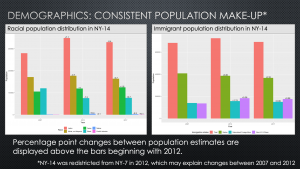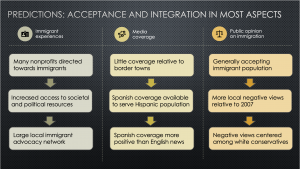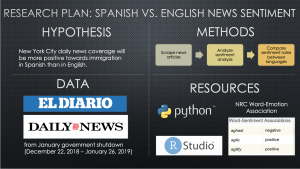
Introduction Slide
Alexandria Ocasio-Cortez (AOC) represents congressional district NY-14, which covers the upper Bronx and northwestern Queens. On the left is a picture of AOC and the right panel shows a sketch of Astoria, Queens overlooking Manhattan.

Slide #1
NY-14 has a diverse, yet fairly consistent population. This Hispanic population comprises the plurality of the district’s racial make-up at over 47%. NY-14 also has high proportions of foreign-born naturalized citizens (21.6%) and non-U.S.-citizens (25.4%), though the majority are native-born. Percentage point (pp) changes are illustrated on the top of each bar, beginning in 2012. Because NY-14 was redistricted in 2012, population changes are difficult to measure for a 10-year period. A 7.1 pp increase is seen in the Latinx population between 2007 and 2012 as well as a 7.2 pp decrease in the black population. Similarly, a 6.49 pp decrease is seen in native born constituents with a 5.36 pp rise in non-U.S. citizens between 2007 and 2012. However, these changes may be due to redistricting. No large population changes are seen between 2012 and 2017, so this may be evidence that the district’s population has remained fairly consistent with strong minority and immigrant representation.

Slide #2
Academic literature points towards general ingroup acceptance but outgroup rejection of immigrant populations. Specifically, Els de Graauw showed that an increase in immigrants led to the creation of nonprofit advocacy groups focused on immigrant societal and political integration (2008). In the same paper, and supported by Andersen (2008), nonprofit organizations of this type were shown to improve immigrant experiences by access to resources. That said, media coverage of immigration typically adopts a negative tone, especially in news sources located close to the U.S.-Mexico border (Farris & Mohamed, 2018; Abrajano & Hajnal, 2015; Branton, 2009). Abrajano & Singh also analyzed the difference in tone between English and Spanish news sources and found that the Spanish sources were typically more positive about immigration, and that Spanish news consumers tended to favor immigration more than English-only consumers (2009). Finally, various studies have illustrated an association between increased immigration and local anti-immigrant views (Hopkins, 2010; Enos, 2014). In particular, white constituents are likely to be less supportive of immigration and to vote for conservative causes, especially in areas with high Latinx populations (Abrajano & Hajnal, 2015; Dunaway et al., 2010).

Slide #3
Given the aforementioned literature, the following predictions were made about NY-14. Because of the high proportion of immigrants and minority constituents, NY-14 is expected to have many nonprofits working on immigrant issues, which would in turn lead to increased access to social and political resources as well as a large local immigrant advocacy network. NY-14 is situated far from the border, so it is expected to have less immigration news coverage in general. Additionally, because of the high Latinx population, NY-14 is expected to have access to Spanish news sources that are more positive than local English sources, as found in Abrajano & Singh (2009). The district’s population has remained relatively consistent, with minority members comprising a large majority of the population and a high proportion of immigrants. Because of this, NY-14 is expected to be generally accepting of the immigrant population. An increase in immigrants and Hispanic residents was seen between 2007 and 2012, so a prediction could be made that there will be more local anti-immigrant views relative to 2007. However, because of the redistricting, this prediction is inaccurate at best. Additionally, negative views are predicted to be concentrated among the few white conservatives in the area, though, as seen in previous projects, the Republican party does not have a strong constituent base in NY-14.

Slide #4
Due to data availability and the demographic make-up of NY-14, I chose to develop a research plan dedicated to testing the local news sources, hypothesizing that the Spanish coverage will be more positive towards immigration relative to the English news. In order to test this, I will examine news from the New York Daily News (English) and El Diario (Spanish) from between December 22, 2018 – January 26, 2019. The dates correspond to the January U.S. government shutdown over funding to build a wall on the Mexican border, with the addition of one day at the end to catch any coverage immediately after the passage of the budget. To analyze the sentiments, I will first use Python web-scraping to form a database of news articles from both sources. Then, sentiments will be analyzed using the NRC Word-Emotion Association dictionary, which gives negative/positive ratings as well as feelings such as “disgust” and “anger” associated with each word. Unfortunately, no Spanish equivalent exists; however, NRC provides a dictionary for 105 different languages related to the English dictionary through Google Translate. There are obvious inaccuracies involved with the use of Google Translate, but the NRC dictionary has been tested profusely in both languages with high accuracy for determining word sentiment. Finally, the sentiment rates between the Daily News and El Diario will be compared to see which reported more positively/negatively about immigration.